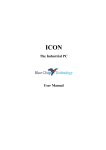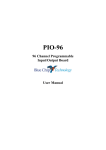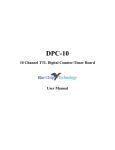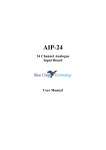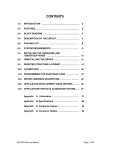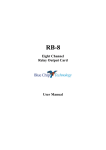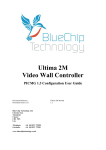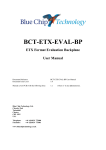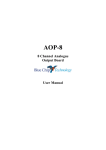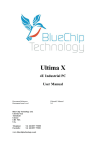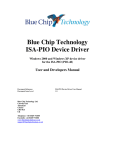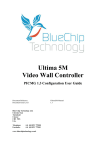Download ISA-PIO User Guide - Blue Chip Technology
Transcript
ISA-PIO 48 Channel TTLDigital I/O Board User Manual ISA-PIO User Manual Document Part No Document Reference Document Issue Level 0127-0181 ISA-PIO\..\0127-0181.Doc 0.8 Manual covers PCBs identified ISA-PIO Rev B All rights reserved. No part of this publication may be reproduced, stored in any retrieval system, or transmitted, in any form or by any means, electronic, mechanical, photocopied, recorded or otherwise, without the prior permission, in writing, from the publisher. For permission in the UK contact Blue Technology. Information offered in this manual is correct at the time of printing. Blue Chip Technology accepts no responsibility for any inaccuracies. This information is subject to change without notice. All trademarks and registered names acknowledged. Blue Chip Technology Ltd. Chowley Oak, Tattenhall Chester, Cheshire CH3 9EX. Telephone : 01829 772000 Facsimile : 01829 772001. Chip Amendment History Issue Level 0.7 0.8 Issue Date 05.05.89 21.07.97 Author Amendment Details LP SEJ First issue Window front cover and new logo Contents OUTLINE DESCRIPTION ................................ ................................ .. 1 1.0 SPECIFICATION ................................ ................................ .......... 1.1 Electrical Specification ................................ ............................ 1.2 Physical Specification ................................ ............................ Electromagnetic Compatibility (EMC) ................................ ............. EMC Specification ................................ ................................ ......... 2 2 2 3 4 2.0 USER ADJUSTMENTS ................................ ................................ 2.1 Selecting the Base Address ................................ ...................... Figure 1 - Selecting the Base Address ................................ ............ 2.2 Port Map ................................ ................................ .................. 5 5 6 7 3.0 ELECTRICAL OPTIONS ................................ ............................. 9 3.1 Input conditioning ................................ ................................ .... 9 3.2 Input/Output Connections ................................ ........................ 9 Pin Detail ................................ ................................ ..................... 10 3.3 Connector Pin Details ................................ ............................ 11 4.0 OPERATING GUIDE ................................ ................................ 12 4.1 Using the Device ................................ ................................ .. 12 4.2 Programming Guide ................................ .............................. 13 4.3 Example Program ................................ ................................ . 16 5.0 COMMERCIAL DATA ACQUISITION PACKAGES .................. 17 5.1 Use of the ISA-PIO Board with ASYST ................................ ... 17 Blue Chip Technology Ltd. 01270181.doc Contents APPENDIX A ................................ ................................ ................... 18 APPENDIX B ................................ ................................ ................... 20 PC/XT/AT Port Map ................................ ................................ ..... 20 I/O Address Map ................................ ................................ .......... 20 APPENDIX C ................................ ................................ ................... 21 PC/XT Interrupt Map ................................ ................................ .... 21 APPENDIX D ................................ ................................ ................... 22 AT Interrupt Map ................................ ................................ .......... 22 APPENDIX F ................................ ................................ .................... 23 Application Notes for Interfacing the ISA-PIO ................................ . 23 Glossary ................................ ................................ ....................... 25 01270181.doc Blue Chip Technology Ltd. Outline Description Page 1 OUTLINE DESCRIPTION This card provides 48 programmable digital I/O channels. It is suitable for sensing the presence of or driving TTL connections only. There is provision for a set of on board pull up resistors to enable the board to be used to detect contact closures on push buttons, relay contacts etc. Blue Chip Technology Ltd 01270181.doc Page 1 Page 2 Specification 1.0 SPECIFICATIONS 1.1 Electrical Specification Number of channels I/O Logic Levels ‘ ON’ Maximum I/O Voltage Power Requirement Power Dissipation Max Sink Current (Output) Max Source Current 1.2 Physical Specification Height Width Depth Page 2 48 2.4V to 5V TTL Level 5V 5V D.C. @ 150mA 500mW 1.7mA @ 0.45V 200uA @ 2.4V 107mm 15mm 132mm 01270181.doc Blue Chip Technology Ltd Electromagnetic Compatibility (EMC) Page 3 Electromagnetic Compatibility (EMC) This product meets the requirements of the European EMC Directive (89/336/EEC) and is eligible to bear the CE mark. It has been assessed operating in a Blue Chip Technology Icon industrial PC. However, because the board can be installed in a variety of computers, certain conditions have to be applied to ensure that the compatibility is maintained. It meets the requirements for an industrial environment (Class A product) subject to those conditions. The board must be installed in a computer system which provides screening suitable for the industrial environment. Any recommendations made by the computer system manufacturer/supplier must be complied with regarding earthing and the installation of boards. The board must be installed with the backplate securely screwed to the chassis of the computer to ensure good metal-to-metal (i.e. earth) contact. Most EMC problems are caused by the external cabling to the board. Boards fitted with IDC ribbon cable connectors on the metal mounting bracket require particularly careful installation of the external cabling. The cabling must be totally screened; the type of ribbon cable which is rolled to a round form with a braided wire screen is best. Standard ribbon cable will not be adequate unless it is contained wholly within the cabinetry housing the industrial PC. Keep the unscreened section as short as possible. The mounting bracket of the board includes a captive nut as an screen earth point. Connect the screen of the cable to this by the shortest possible wire. To ensure that the board meets the industrial radiated field immunity of 10V/metre, the cable should also be fitted with a ferrite clamp on the external cable as close as possible to the connector. The preferred type is the Chomerics clip-on-style, type H8FE-1004-AS. Blue Chip Technology Ltd 01270181.doc Page 3 Page 4 Electromagnetic Compatibility (EMC) Ensure that the screen of the ribbon cable is bonded to a good RF earth at the remote end of the cable. Cables which connect externally to boards at TTL levels should not exceed two metres in length. This restriction does not apply to opto-isolated boards. Failure to observe these recommendations may invalidate the EMC compliance. Warning This is a Class A product. In a domestic environment this product may cause radio interference in which case the user may be required to take adequate measures. EMC Specification A Blue Chip Technology Icon industrial PC fitted with this card meets the following specification: Emissions: EN 55022:1995 Radiated Conducted Immunity: Page 4 Class A Class A & B pr EN 50082-2:1991 incorporating: Electrostatic Discharge IEC 801-2:1984 Performance Criteria A Radio Frequency Susceptibility IEC 801-3:1984 Performance Criteria A Fast Burst Transients IEC 801-4:1988 Performance Criteria A 01270181.doc Blue Chip Technology Ltd User Adjustments 2.0 USER ADJUSTMENTS 2.1 Selecting the Base Address Page 5 The board may be located in any 62 pin slot in the PC motherboard but must be set up to appear at a specified position (or ‘ address’ ) in the port map. Available positions are shown in the IBM-PC Technical Reference Guide. However, for those who do not possess a copy of this document a good place is the location normally allocated to the prototyping card as supplied by IBM. This address is 300 Hex or 768 decimal. All Blue Chip Technology cards are preset to this address at the factory. However, no two devices should be used while set to the same address since contention will occur and neither board will work. If your machine contains a card with a conflicting address then another reasonably safe address is 200 to 21F (Hex). A set of links is provided on the board to set the base address of the board within the IBM-PC port map. The address is in binary with the presence of a link representing a 0 and the absence of a link representing a 1. To set the base address to 768 Decimal (300 Hex) set the following pattern on the links as indicated below Blue Chip Technology Ltd 01270181.doc Page 5 Page 6 User Adjustments Figure 1 - Selecting the Base Address Note: View board with back panel on RHS. Middle 7 bits of port address on links. MSB LSB 8 10 20 40 80 100 200 More example addresses are shown in Appendix A. Note: No two cards must occupy the same address. Page 6 01270181.doc Blue Chip Technology Ltd User Adjustments 2.2 Page 7 Port Map The ISA-PIO has two 8255 chips. Each chip has three 8 bit ports which can be programmed as input or output by writing a control word to the control port. (See Table 3). Port A and B (A’ and B’ ) must be all input or all output. Port C may be split into two 4 bit sections each of which may be input or output. The board occupies eight read/write addresses (four for each 8255 chip) in the IBM-PC port map. Address Base + 0 Base + 1 Base + 2 Base + 3 Port A Port B Port C Command Port Base + 4 Base + 5 Base + 6 Base + 7 Port A’ Port B’ Port C’ Command Port 7 6 5 4 8255 N 1 8255 N 2 3 2 1 0 DATA (8255 PORT A) Blue Chip Technology Ltd 01270181.doc Page 7 Page 8 User Adjustments 7 6 5 4 3 2 1 0 2 1 0 1 0 DATA (8255 PORT B) 7 6 5 4 3 DATA (8255 PORT C) 7 6 5 4 3 2 CONTROL Bit 0 = Port C (Lower) Bit 1 = Port B Bit 2 = Mode Selection Bit 3 = Port C (Upper) Bit 4 = Port A Bits 5,6 = Mode Selection Bit 7 = Mode Set Flag 0 = Output, 0 = Output, 0 = Mode 0, 0 = Output, 0 = Output, 00 = Mode 0, 1X = Mode 2. 0 = Inactive, 1 = Input. 1 = Input. 1 = Mode 1. 1 = Input. 1 = Input. 01 = Mode 1, 1 = Active. See Table 3 for quick set-up guide. Page 8 01270181.doc Blue Chip Technology Ltd Electrical Options 3.0 ELECTRICAL OPTIONS 3.1 Input conditioning Page 9 The 8255 has high impedance inputs. An option is provided to terminate external input lines. This is useful in an electrically noisy environment or where a load is required (e.g. open collector drive). The termination may be pull up (to 5V) or pull down (to 0V) via 6 SIL resistor packs (RP 2-7). Links B-G select pull up or pull down. (See circuit diagram). 3.2 Input/Output Connections A 50 way insulation displacement connector (IDC) is provided on the PC rear panel of the board for I/O channel signal connection. If access to individual channels is required, a 50 way IDC ribbon cable may be used to connect the I/O channels to a 50 way screw terminal block available from Blue Chip Technology as part number ST-24. The pins are numbered as shown in the following diagram. Pins 1-48 contain the I/O channels and pins 49 and 50 are connected to digital ground. When the connector is viewed from the back of the system odd numbered pins are on the left and even numbered pins are on the right with pin 1 at the top of the connector. Blue Chip Technology Ltd 01270181.doc Page 9 Page 10 Electrical Options Pin Detail Pin Pin 1 3 Pin Pin . . . . . . . Pin Pin 2 4 . . . . . . . 47 49 Pin Pin 48 50 View with gold edge connectors downwards. Page 10 01270181.doc Blue Chip Technology Ltd Electrical Options 3.3 Page 11 Connector Pin Details Port A Bit 0 1 2 3 4 5 6 7 Pin 1 3 5 7 9 11 13 15 Pin 2 4 6 8 10 12 14 16 Port B Bit 0 1 2 3 4 5 6 7 Pin 17 19 21 23 25 27 29 31 Pin 18 20 22 24 26 28 30 32 Bit 0 1 2 3 4 5 6 7 Port B’ Port C Bit 0 1 2 3 4 5 6 7 Pin 33 35 37 39 41 43 45 47 Pin 34 36 38 40 42 44 46 48 Bit 0 1 2 3 4 5 6 7 Port C’ Digital Ground Blue Chip Technology Ltd 49 50 Bit 0 1 2 3 4 5 6 7 Port A’ Digital Ground 01270181.doc Page 11 Page 12 Operating Gu ide 4.0 OPERATING GUIDE 4.1 Using the Device A total of 24 I/O channel signals may be connected to each of the 8255 I/O devices on the ISA-PIO board providing 6 eight bit ports. Each signal is connected to one bit within one of these ports, i.e. Port Add +0 +1 +2 Page 12 Bit Hex Decimal 0 1 2 3 4 5 6 7 01 02 04 08 10 20 40 80 1 2 4 8 1 32 64 128 0 1 2 3 4 5 6 7 01 02 04 08 10 20 40 80 1 2 4 8 16 32 64 128 0 1 2 3 4 5 6 7 01 02 04 08 10 20 40 80 1 2 4 8 16 32 64 128 Port Add +4 +5 +6 01270181.doc Bit Hex Decimal 0 1 2 3 4 5 6 7 01 02 04 08 10 20 40 80 1 2 4 8 16 32 64 128 0 1 2 3 4 5 6 7 01 02 04 08 10 20 40 80 1 2 4 8 16 32 64 128 0 1 2 3 4 5 6 7 01 02 04 08 10 20 40 80 1 2 4 8 16 32 64 128 Blue Chip Technology Ltd Operating Guide 4.2 Page 13 Programming Guide The state of the input lines may be determined by using either of the following methods:(a) Microsoft BASIC A or GW BASIC. X=INP (P) Returns the byte from port P and assigns this value to the variable, X. (b) 8088/8086 Assembly language. PORT EQU 0300H GETDAT: MOV IN RET Blue Chip Technology Ltd DX, PORT AL,DX 01270181.doc Page 13 Page 14 Operating Guide The state of the output lines may be modified by using either of the following methods:(a) Microsoft BASIC A or GW BASIC. OUT P, D Outputs the byte D to port P. (b) 8088/8086 Assembly language PORT EQU 0300H PUTDAT: MOV MOV OUT RET Page 14 DX, PORT AX, DATA DX, AL 01270181.doc Blue Chip Technology Ltd Operating Guide Page 15 The following table gives a summary of the most commonly used ‘ control words’ which must be written to the control port to configure the 8255 before using this module. The 8255 can operate in one of 3 modes (mode 0-2). In the first mode (mode 0) the 8255 provides simple I/O for 3, 8 bit ports. Data is simply written to or read from a specified port (A, B or C) without the use of handshaking. The following Control Code Table (3) assumes mode 0 is required. Mode 1 enables the transfer of data to or from a specified 8 bit port (A or B) in conjunction with strobes or handshaking signals. In mode 2 data is transferred via one bi-directional 8 bit port (A) with handshakes (Port C). Control Word (Hex) 80 81 82 83 88 89 8A 8B 90 91 92 93 98 99 9A 9B Control Word (Decimal) 128 129 130 131 136 137 138 139 144 145 146 147 152 153 154 155 Sets All of Port A To Output Output Output Output Output Output Output Output Input Input Input Input Input Input Input Input Sets All of Port B To Output Output Input Input Output Output Input Input Output Output Input Input Output Output Input Input Sets High 4 Bits of Port C To Output Output Output Output Input Input Input Input Output Output Output Output Input Input Input Input Sets Low 4 Bits of Port C To Output Input Output Input Output Input Output Input Output Input Output Input Output Input Output Input Table 3 - Control Word Table Blue Chip Technology Ltd 01270181.doc Page 15 Page 16 4.3 Operating Guide Example Program The following program in Microsoft Basic will test the operation of the ISA-PIO if a link is made between corresponding pins on the rear connector. 10 15 20 30 40 50 60 70 80 90 100 110 120 130 140 150 160 170 180 P1=&H300 : REM BASE OF FIRST PIA P2 = &H304 : REM BASE OF SECOND PIA GOSUB 60 P1 = &H304 : P2 = &H300 GOSUB 60 GOTO 10 : REM LOOP CONTINUOSLY OUT P1+3, &H80 : OUT P2+3, &H9B FOR P = 0 TO 2 F=0 A=1 OUT P1+P, A IF INP (P2+P)<>A THEN PRINT ERROR , P, A, INP (P2+P) : F=F+1 A=A+A IF A=256 THEN GOTO 150 GOTO 100 IF F>0 THEN PRINT P, FAILED , F : GOTO 170 PRINT P, PASSED NEXT P RETURN The above program runs continuously and can only be stopped by pressing control and break on the PC keyboard. Page 16 01270181.doc Blue Chip Technology Ltd Commercial Data Acquisition Packages 5.0 Page 17 COMMERCIAL DATA ACQUISITION PACKAGES The Blue Chip Technology ISA-PIO can be used with almost any data acquisition package that can read information directly from a PC input port. 5.1 Use of the ISA-PIO Board with ASYST The board has been tested with and is installable as an 8255.PORT digital device in the ASYST scientific software package by Macmillan Software Company. For more details about this package and other PC data acquisition software please contact Blue Chip Technology. Whilst every effort has been taken to ensure that the information provided is accurate, Blue Chip Technology cannot assume responsibility for any error in this manual or their consequences. Should any errors be detected, the company would greatly appreciate being informed of them. A policy of continuous product development is operated, resulting in the contents of this document being subject to change without notice. Blue Chip Technology Ltd 01270181.doc Page 17 Page 18 Appendix A APPENDIX A Note: View board with back panel on RHS. Address Settings for Port 300H MSB LSB 8 10 20 40 80 100 200 Address Settings for Port 200H MSB LSB 8 10 20 40 80 100 200 Address Settings for Port 208H MSB LSB 8 Page 18 10 20 40 01270181.doc 80 100 200 Blue Chip Technology Ltd Appendix A Page 19 Address Settings for Port 210H MSB LSB 10 8 20 40 80 100 200 Address Settings for Port 220H MSB LSB 8 10 20 40 80 100 200 Address Settings for Port 230H MSB LSB 8 Blue Chip Technology Ltd 10 20 40 80 100 200 01270181.doc Page 19 Page 20 Appendix B APPENDIX B PC/XT/AT Port Map I/O Address Map Address 000-01F 020-03F 040-05F 060-06F 070-07F 080-09F 0A0-0BF 0F0 0F1 0F8-0FF 1F0-1F8 200-207 278-27F 2F8-2FF 300-31F 360-36F 378-37F 380-38F 3A0-3AF 3B0-3BF 3C0-3CF 3D0-3DF 3F0-3F7 3F8-3FF Page 20 DMA Controller 1, 8237A-5 Interrupt Controller 1, 8259A Timer, 8254 Keyboard Controller, 8742; Control Port B RTC and CMOS RAM, NMI Mask (Write) DMA Page Register (Memory Mapper) Interrupt Controller 2, 8259 Clear NPX (80287) Busy Reset NPX, 80287 Numeric Processor Extension, 80287 Hard Disk Drive Controller Reserved Reserved for Parallel Printer Port 2 Reserved for Serial Port 2 Reserved Reserved Parallel Printer Port 1 Reserved for SDLC Communications, Bisynchronous 2 Reserved for Bisynchronous 1 Reserved Reserved Display Controller Diskette Drive Controller Serial Port 1 01270181.doc Blue Chip Technology Ltd Appendix C Page 21 APPENDIX C PC/XT Interrupt Map Number Usage NMI Parity 0 1 2 3 Timer Keyboard Reserved Asynchronous Communications (Secondary) SDLC Communications Asynchronous Communications (Primary) SDLC Communications Fixed Disk Diskette Parallel Printer 4 5 6 7 Blue Chip Technology Ltd 01270181.doc Page 21 Page 22 Appendix D APPENDIX D AT Interrupt Map Level Function Microprocessor NMI Parity or I/O Channel Check Interrupt Controllers CTLR 1 CTLR2 IRQ 0 IRQ 1 IRQ 2 IRQ 8 IRQ 9 IRQ 10 IRQ 11 IRQ 12 IRQ 13 IRQ 14 IRQ 15 IRQ 3 IRQ 4 IRQ 5 IRQ 6 IRQ 7 Page 22 Timer Output 0 Keyboard (Output Buffer Full) Interrupt from CTLR 2 Realtime Clock Interrupt Software Redirected to INT 0AH ( IRQ 2) Reserved Reserved Reserved Coprocessor Fixed D isk Controller Reserved Serial Port 2 Serial Port 1 Parallel Port 2 Diskette Controller Parallel Port 1 01270181.doc Blue Chip Technology Ltd Appendix F Page 23 APPENDIX F Application Notes for Interfacing the ISA-PIO The signals present at ports A, B & C on either the NMOS or CMOS 8255 are TTL (Transistor Transistors Logic) compatible, that is they will interface into standard 74LS logic. However, TTL has limitations when interfacing to other circuitry. The following should be considered when attempting to interface the ISA-PIO: 1). 2). 3). 4). 5). ISA-PIO cannot drive high capacitances. ISA-PIO cannot sink loads greater than 2.5mA and retain an output voltage that is TTL compatible. ISA-PIO cannot source loads greater than - 200uA (-400uA for CMOS version) and retain an output voltage that is TTL compatible. ISA-PIO cannot interface to any voltage greater than VCC ( VDD) + 0.5 or lower than - 0.5V. ISA-PIO cannot drive long lengths of cable into other TTL compatible devices. TTL is a standard for onboard interfacing primarily and is too susceptible to interference and noise to be used with long cable runs. General TTL requirement:LOW HIGH Input 0.5 - 0.8V Output 0 - 0.45V 2.0 - Vcc ( VDD) 2.4 - Vcc ( VDD) Blue Chip Technology Ltd 01270181.doc Page 23 Page 24 Appendix F Characteristics: DC PARAMETER SYMBOL 8255 82C55 MIN MAX MIN LIMITS Input Voltage High Input Voltage Low Output Voltage High Output Voltage Low Input Leakage Current High Input Leakage Current Low Output Leakage Current High Output Leakage Current Low Supply Current (Dynamic) Supply Current (Standby) Page 24 VIH VIL VOH VOL ILIH ILIL ILOH ILOL IDDI IDD2 2 -O.5V 2.4V 01270181.doc VCC 0.8V @-20uA IOL=1.7MA 0.45V VI = VCC 10uA -10uA 10uA -10uA 120mA 120mA MAX LIMITS 2.2 -0.5V 3.5 2uA Blue Chip Technology Ltd VDD+0.3V 0.8V IOH=-400uA IOL=2.5MA 0.4V VI = VDD 10uA VI = 0V -10uA VO = VDD 10uA VO = OV -10uA 15MA 50uA Glossary Page 25 Glossary VIH - High level input voltage - the minimum and maximum voltages that can be applied ( ref to 0V) for a high to be recognised. VIL - Low level input voltage - the minimum and maximum voltages that can be applied ( ref to 0V) for a low to be recognised. VOH - High level output voltage - the minimum that will be presented at the output as a high at a given max current source current. VOL - Low level output voltage - the maximum voltage that will be presented at the output as a low at a given maximum current load. Blue Chip Technology Ltd 01270181.doc Page 25
































